Free Microsoft AZ-104 Exam Dumps
Here you can find all the free questions related with Microsoft Azure Administrator Exam (AZ-104) exam. You can also find on this page links to recently updated premium files with which you can practice for actual Microsoft Azure Administrator Exam . These premium versions are provided as AZ-104 exam practice tests, both as desktop software and browser based application, you can use whatever suits your style. Feel free to try the Microsoft Azure Administrator Exam premium files for free, Good luck with your Microsoft Azure Administrator Exam .Hotspot
You have an Azure subscription named Subscription1 that contains the virtual networks in the following table.
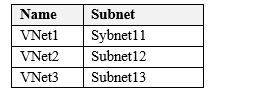
Subscripton1 contains the virtual machines in the following table.

In Subscription1, you create a load balancer that has the following configurations:
Name: LB1
SKU: Basic
Type: Internal
Subnet: Subnet12
Virtual network: VNET1
For each of the following statements, select Yes if the statement is true. Otherwise, select No.
NOTE: each correct selection is worth one point.

Statement 1 :Basic load balancer supports Virtual machine in a single Availability set or virtual machine scale set (VMSS) only . Hence this statement is correct.
Statement 2 :Basic load balancer supports Virtual machine in a single Availability set or virtual scale set only or one standalone VM. VM3 and VM4 are not part of any availability set or VMSS .Hence this statement is incorrect.
Statement 3 :Basic load balancer supports Virtual machine in a single Availability set or virtual scale set only or one standalone VM. VM5 and VM6 are not part of any availability set or VMSS .Hence this statement is incorrect.

References:
Hotspot
You have an Azure subscription.
You create the Azure Storage account shown in the following exhibit.
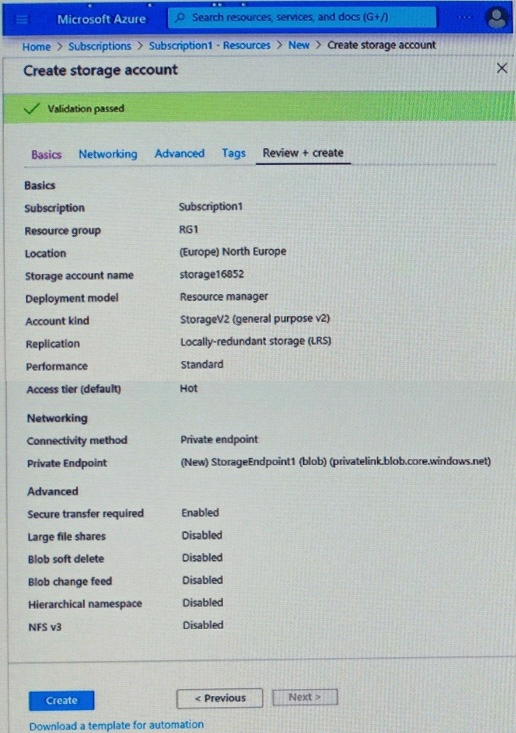
Use the drop-down menus to select the answer choice that completes each statement based on the information presented in the graphic.
NOTE: Each correct selection is worth one point.
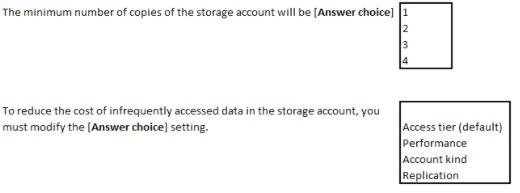
Box1:LRS will keep minimum three copies.
Box2:Changing the access tier from hot to cool will reduce the cost. In performance, standard is cheap.
In the Account kind, GPV2 is giving best price. Can be checked yourself using the pricing calculator on below link.
Hotspot
You plan to use Azure Network Watcher to perform the following tasks:
Task1: Identify a security rule that prevents a network packet from reaching an Azure virtual machine
Task2: Validate outbound connectivity from an Azure virtual machine to an external host
Which feature should you use for each task? To answer, select the appropriate options in the answer area.
NOTE: Each correct selection is worth one point.
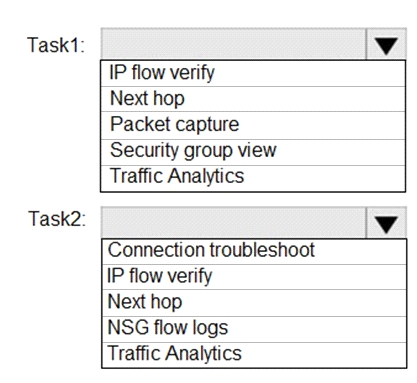
Task 1: IP flow verify
The IP flow verify capability enables you to specify a source and destination IPv4 address, port, protocol (TCP or UDP), and traffic direction (inbound or outbound). IP flow verify then tests the communication and informs you if the connection succeeds or fails. If the connection fails, IP flow verify tells you which security rule allowed or denied the communication, so that you can resolve the problem.
Task 2: Connection troubleshoot
The connection troubleshoot capability enables you to test a connection between a VM and another VM, an FQDN, a URI, or an IPv4 address. The test returns similar information returned when using the connection monitor capability, but tests the connection at a point in time, rather than monitoring it over time.
Hotspot
You have an Azure virtual machine named VM1 that connects to a virtual network named VNet1. VM1 has the following configurations:
Subnet: 10.0.0.0/24
Availability set: AVSet
Network security group (NSG): None
Private IP address: 10.0.0.4 (dynamic)
Public IP address: 40.90.219.6 (dynamic)
You deploy a standard, Internet-facing load balancer named slb1.
You need to configure slb1 to allow connectivity to VM1.
Which changes should you apply to VM1 as you configure slb1? To answer, select the appropriate options in the answer area.
NOTE: Each correct selection is worth one point.

Box 1:Remove the public IP address from VM1
If the Public IP on VM1 is set to Dynamic, that means it is a Public IP with Basic SKU because Public IPs with Standard SKU have Static assignments by default, that cannot be changed. We cannot associate Basic SKUs IPs with Standard SKUs LBs. One cannot create a backend SLB pool if the VM to be associated has a Public IP. For Private IP it doesn't matter weather it is dynamic or static, still we can add the such VM into the SLB backend pool.
Box 2:Create and configure an NSG
Standard Load Balancer is built on the zero trust network security model at its core. Standard Load Balancer secure by default and is part of your virtual network. The virtual network is a private and isolated network. This means Standard Load Balancers and Standard Public IP addresses are closed to inbound flows unless opened by Network Security Groups. NSGs are used to explicitly permit allowed traffic. If you do not have an NSG on a subnet or NIC of your virtual machine resource, traffic is not allowed to reach this resource. To learn more about NSGs and how to apply them for your scenario, see Network Security Groups. Basic Load Balancer is open to the internet by default.
DragDrop
You have an Azure subscription that contains a storage account.
You have an on-premises server named Server1 that runs Window Server 2016. Server1 has 2 TB of data.
You need to transfer the data to the storage account by using the Azure Import/Export service.
In which order should you perform the actions? To answer, move all actions from the list of actions to the answer area and arrange them in the correct order.
NOTE: More than one order of answer choices is correct. You will receive credit for any of the correct orders you select.

















At a high level, an import job involves the following steps:
Step 1: Attach an external disk to Server1 and then run waimportexport.exe
Determine data to be imported, number of drives you need, destination blob location for your data in Azure storage.
Use the WAImportExport tool to copy data to disk drives. Encrypt the disk drives with BitLocker.
Step 2: From the Azure portal, create an import job.
Create an import job in your target storage account in Azure portal. Upload the drive journal files.
Step 3: Detach the external disks from Server1 and ship the disks to an Azure data center.
Provide the return address and carrier account number for shipping the drives back to you.
Ship the disk drives to the shipping address provided during job creation.
Step 4: From the Azure portal, update the import job
Update the delivery tracking number in the import job details and submit the import job.
The drives are received and processed at the Azure data center.
The drives are shipped using your carrier account to the return address provided in the import job.
References:
Hotspot
You have an on premises data center and an Azure subscription. The data center contains two VPN devices. The subscription contains an Azure virtual network named VNet1. VNet1 contains a gateway subnet.
You need to create a site-to-site VPN. The solution must ensure that if a single instance of an Azure VPN gateway fails, or a single on-premises VPN device fails, the failure will not cause an interruption that is longer than two minutes.
What is the minimum number of public IP addresses, virtual network gateways, and local network gateways required in Azure? To answer, select the appropriate options in the answer area.
NOTE: Each correct selection is worth one point.
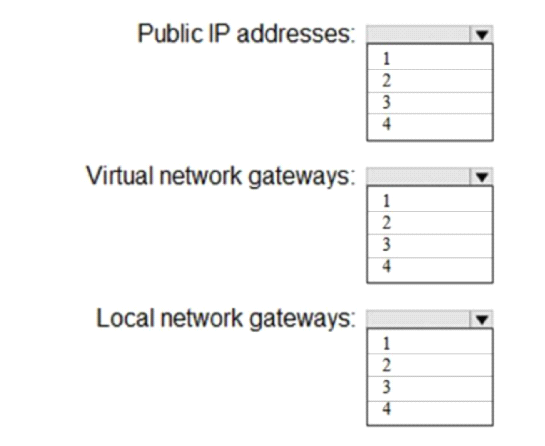
Box 1: 4
Two public IP addresses in the on-premises data center, and two public IP addresses in the VNET.
The most reliable option is to combine the active-active gateways on both your network and Azure, as shown in the diagram below.

Box 2: 2
Every Azure VPN gateway consists of two instances in an active-standby configuration. For any planned maintenance or unplanned disruption that happens to the active instance, the standby instance would take over (failover) automatically, and resume the S2S VPN or VNet-to-VNet connections.
Box 3: 2
Dual-redundancy: active-active VPN gateways for both Azure and on-premises networks
Hotspot
You have an Azure subscription named Subscription1 that has a subscription ID of c276fc76-9cd4-44c9-99a7-4fd71546436e.
You need to create a custom RBAC role named CR1 that meets the following requirements:
Can be assigned only to the resource groups in Subscription1
Prevents the management of the access permissions for the resource groups
Allows the viewing, creating, modifying, and deleting of resource within the resource groups
What should you specify in the assignable scopes and the permission elements of the definition of CR1? To answer, select the appropriate options in the answer area.
NOTE: Each correct selection is worth one point.
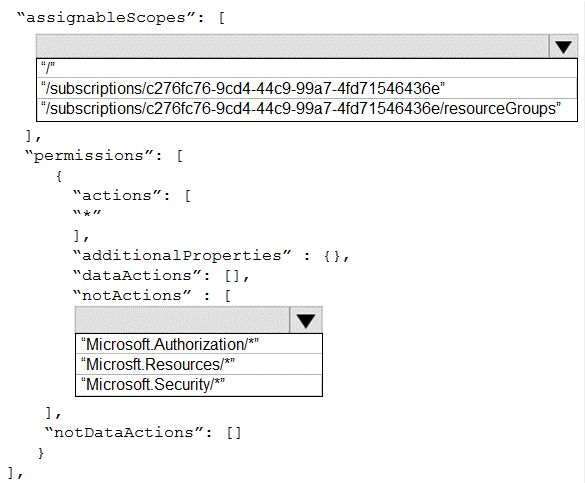

Box 1:"/subscription/c276fc76-9cd4-44c9-99a7-4fd71546436e"
In the assignableScopes you need to mention the subscription ID where you want to implement the RBAC
Box 2:"Microsoft.Authorization/*"
Microsoft.Authorization/* is used to Manage authorization
References:
References:
Hotspot
You have an Azure subscription.
You need to implement a custom policy that meet the following requirements:
*Ensures that each new resource group in the subscription has a tag named organization set to a value of Contoso.
*Ensures that resource group can be created from the Azure portal.
*Ensures that compliance reports in the Azure portal are accurate.
How should you complete the policy? To answer, select the appropriate options in the answers area.
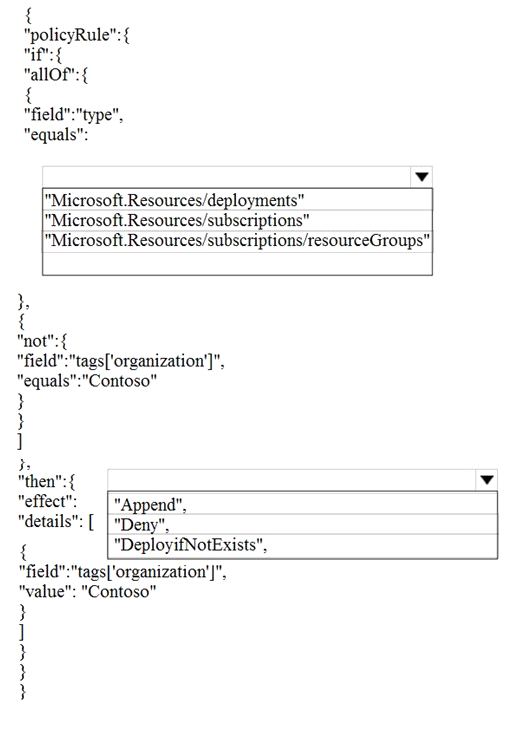
Box 1: "Microsoft.Resources/subscriptions/resourceGroups"
To create a new resource group in a subscription, account have at least the this permission.
Box 2: "Append"
Append adds fields to the resource when theifcondition of the policy rule is met. If the append effect would override a value in the original request with a different value, then it acts as a deny effect and rejects the request. To append a new value to an existing array, use the[*]version of the alias
Hotspot
You need to deploy two Azure web apps named WebApp1 and WebApp2. The web apps have the following requirements:
WebApp1 must be able to use staging slots
WebApp2 must be able to access the resources located on an Azure virtual network
What is the least costly plan that you can use to deploy each web app? To answer, select the appropriate options in the answer area.
NOTE: Each correct selection is worth one point.
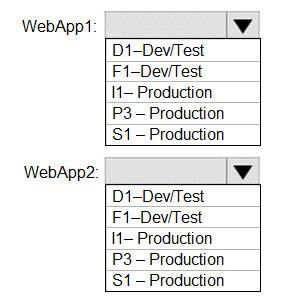
References:
DragDrop
You have an on-premises network that includes a Microsoft SQL Server instance named SQL1.
You create an Azure Logic App named App1.
You need to ensure that App1 can query a database on SQL1.
Which three actions should you perform in sequence? To answer, move the appropriate actions from the list of actions to the answer area and arrange them in the correct order.
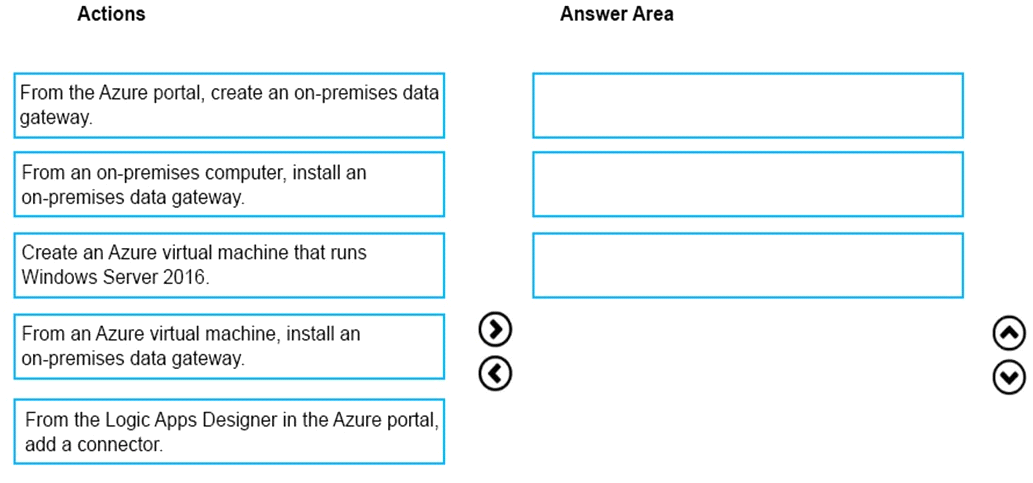









To access data sources on premises from your logic apps, you can create a data gateway resource in Azure so that your logic apps can use the on-premises connectors.
Box 1: From an on-premises computer, install an on-premises data gateway.
Before you can connect to on-premises data sources from Azure Logic Apps, download and install the on-premises data gateway on a local computer.
Box 2: From the Azure portal, create an on-premises data gateway
Create Azure resource for gateway
After you install the gateway on a local computer, you can then create an Azure resource for your gateway. This step also associates your gateway resource with your Azure subscription.
Sign in to the Azure portal. Make sure you use the same Azure work or school email address used to install the gateway.
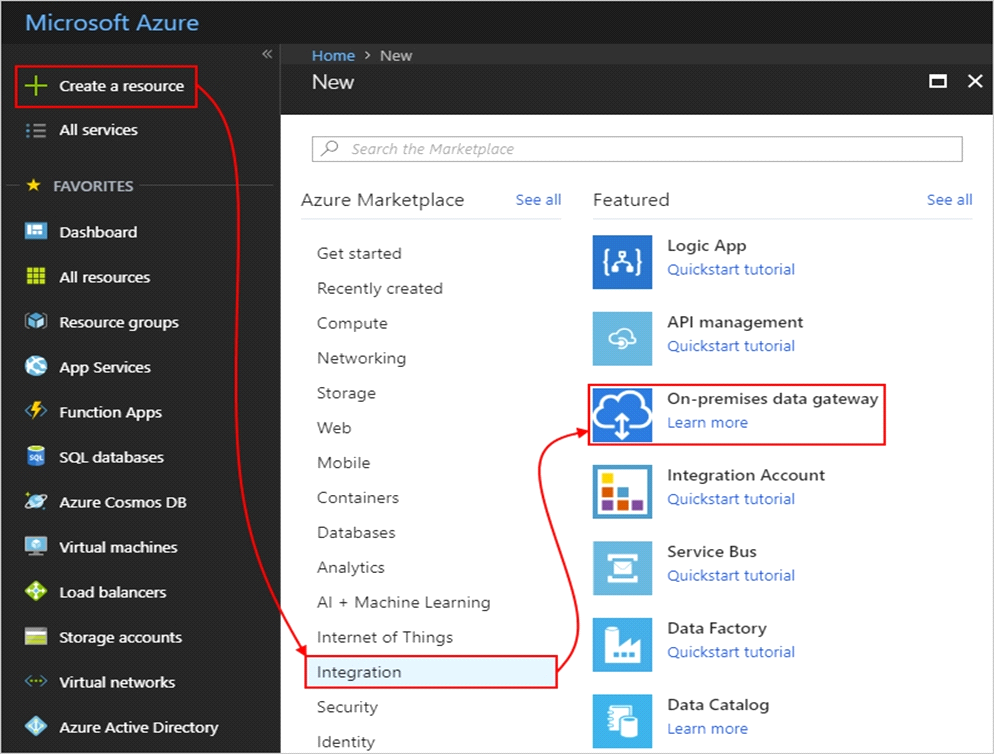









On the Create connection gateway page, provide this information for your gateway resource.
To add the gateway resource to your Azure dashboard, select Pin to dashboard. When you're done, choose Create.
Box 3: From the Logic Apps Designer in the Azure portal, add a connector
After you create your gateway resource and associate your Azure subscription with this resource, you can now create a connection between your logic app and your on-premises data source by using the gateway.
In the Azure portal, create or open your logic app in the Logic App Designer.
Add a connector that supports on-premises connections, for example, SQL Server.
Set up your connection.
References:

